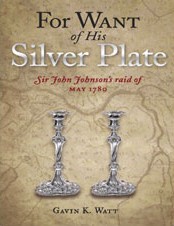For Want of His Silver Plate

Buy from:
Amazon.ca
It is unknown when Sir John Johnson first contemplated a major raid into his homeland of Tryon County’s Mohawk District. After evading capture in May 1776, he had anticipated a very short exile in Quebec and a triumphant return to the family seat of Johnson Hall, but that was not to be. For Want of His Silver Plate relates the history of Sir John Johnson's raid of 1780, providing much detail about individual events and people. Beyond the value of the narrative, the lists included in the Appendices will be of great value to military historians and genealogists alike. About the choice of title of the book: For the title of this book, the author paraphrased a fatuously derisive claim made by the famous American historian Franklin Hough, one of Sir John Johnson’s major detractors. To wit - the primary goal of his May 1780 expedition was to rescue his family’s collection of silver plate. That the raid was sanctioned and supported by the very demanding Governor of Canada, General Frederick Haldimand, was ignored by Hough. Further, that it:
- relieved a large body of loyalists from persecution;
- recruited sufficient men to complete Johnson’s first battalion, and to give birth to his second battalion;
- destroyed substantial supplies of crops and livestock that would have supported the Continental armies;
- resulted in the capture or death of several local supporters of the rebellion, and
- thoroughly alarmed the rebels’ administration including General Washington himself.
- Preface and Acknowledgement
- Chapter One – The Beginning – Exile
- Johnson’s 1777 Role
- 1778 – Johnson’s New Duties
- The Rebels Retaliate
- The appeal of the Captains McDonell
- The Sacandaga Blockhouse
- Alexander Harper
- Crawford’s Raid
- Governor Clinton’s advice
- Disaster at Stanwix
- The Tryon Militia reacts
- The Planning of the Raid
- The Raid Betrayed
- Chapter Three – A Slick Advance and a Slick Withdrawal “You Are My Prisoner”
- The Aftermath
- Endnotes
- Appendices (lists)
- i. Men Captured at Remensnyder’s Bush 03 April 1780
- ii. Tory Absconders Listed by Christopher P. Yates, 15 May 1780
- iii. Royal Yorker Detachment Sent on May 1780 Expedition to Johnstown
- iv. Royal Yorker and Other Recruits of the May 1780 Raid
- v. Transcript of a Return of Blacks Taken by Sir John’s Expedition May 1780
- vi. Some Rebels Taken During 1780 Johnstown Raid
- vii. Listing of Johnson Family’s Silver Plate
- viii. Deserters from the 1st New York Continental Line and Brown’s Company, 3rd Regiment, Continental Army, Fort Schuyler (Stanwix), 22 May 1780
- ix. Some Losses Incurred During the May 1780 Raid
- Bibliography
- Index (Browse the INDEX here)
- 94 Pages
- 8.5 X 11"
- Coil bound
- Sources
- Bibliography
- Index
- Published by Global Heritage Press, Ottawa 2018
- ISBN 978-1-77240-119-6 (printed and bound)
Reviewed by Paul Milner of Park Ridge, Illinois - Journal of the Federation of Genealogical Societies, 2019
With this catchy title, Gavin K. Watt paraphrased a fatuously derisive claim by the famous American historian Franklin Hough, one of Sir John Johnson's major detractors, who claimed that the primary goal of his May 1780 expedition was to rescue the family's collection of silver plate. Hough ignored the fact that the raid was sanctioned and supported by the demanding governor of Canada, General Frederick Haldimand. The raid was significant in that it: relieved a large body of Loyalists from persecution, recruited enough men to fill out Johnson's first battalion and give birth to his second, destroyed substantial supplies of crops and livestock that would have supported the Continental armies, resulted in the capture or death of several local supporters loyal to the rebellion, and thoroughly alarmed the rebels' administration including General George Washington himself. The details of the preparations, implementation, and after effects of the raid from Canada into Tyron County's Mohawk District of New York State are described. The full text is supplemented by color reprints of portrait paintings of some of the leaders, along with detailed maps, especially of the Mohawk District, identifying the location of some of the farms and houses, all naming the occupant families. The genealogist will revel in the appendixes, which include lists of: men captured at Remensynder's Bush on April 3, 1789; Tory absconders listed by Christopher P. Yates on May 15, 1780; Royal Yorker and other recruits on the May 1780 raid; blacks taken by the expedition and sold by the Indians to inhabitants of Montreal; rebels taken during the Johnstown raid and what happened to them; deserters from the 1st New York Continental Line and Brown's Company, 3rd Regiment, Continental Artillery, FortSchulyer(Stanwix) May 22, 1780; and damage resulting from the raid providing a look at the lives of some of the prominent victims. In many of the lists additional information is provided about the men involved such as dates of enlistments, battalion number, how long a prisoner, etc. The book concludes with an extensive bibliography to primary and secondary sources, plus a detailed index. This book is a nice practical, detailed addition to the literature on the Revolutionary War in the Mohawk Valley. It includes many details about the raid, who was involved, and who was affected on both sides. Overall it contains lots of information for the genealogist and the historian, written by a recognized expert on the subject